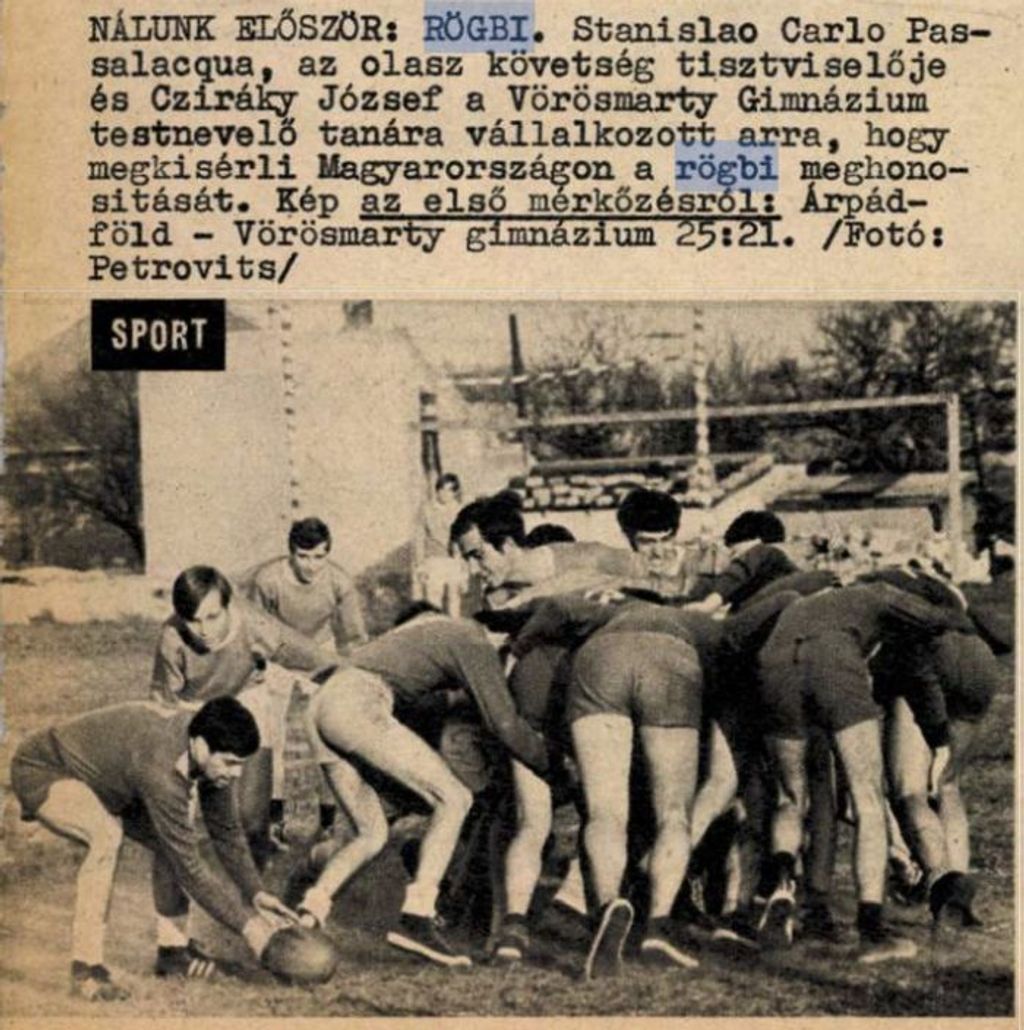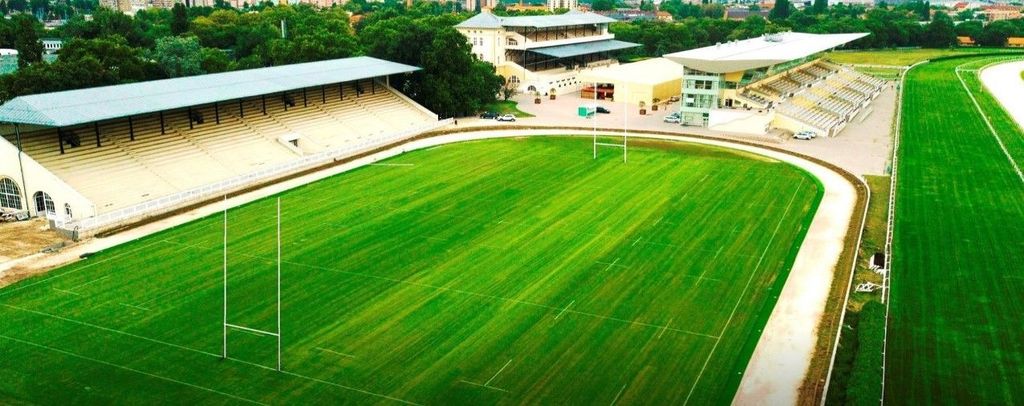The first stadium dedicated to rugby in Hungary officially opened its doors in October this year, demonstrating just how far the sport has come in the country from its humble beginnings exactly half a century ago.
Although English club Rosslyn Park and an amalgamated team made up of Oxford/Cambridge University students had played there immediately before the outbreak of World War II, the first recognised match featuring Hungarian teams in Hungary came in May 1969 when a Árpádföld XV, representing one of the capital’s 16 districts, defeated the students of Vörösmarty Secondary School, 25-21.

Rugby was introduced to the country by a diplomat attached to the Italian Embassy in Budapest called Carlo Passalaqua. Widely credited as the founding father of Hungarian rugby, Passalaqua made the acquaintance of József Cziráki, a professor at Vörösmarty, in the spring of 1969, and special rugby courses were organised there and in other locations around the city.
Around five months after the inaugural game had taken place, the national newspaper of Hungary, ‘Népsport’, reported, on 14 October, 1969, that the first rugby section anywhere in the country had been founded within the Péceli Spartacus club, boasting a 50-strong membership.
Around 50 active clubs were in existence when rugby was at its peak in Hungary, but much of the momentum was lost once Passalaqua returned home a few years later.
Kept alive by the hard work of volunteers, the sport’s popularity continued to ebb and flow. It wasn’t until the communist regime was overthrown in 1990, however, that the Hungarian Rugby Union was formed. Hungary played its first test match in the same year, losing 7-3 to East Germany, on 1 July, 131 days before the fall of the Berlin Wall.
Celtic influence
If an Italian was responsible for the birth of rugby in Hungary, it’s two Welshman and a Scot who have helped to drive the sport forward in recent years.
When Richie Williams took over as high performance director of men’s rugby in August 2016, his adopted nation’s senior men’s team had lost nine on the bounce and slumped to 82nd in the World Rugby Men's Rankings. They’re now 65th, having reached a high of 61st, following an impressive run of results in the Rugby World Cup 2019 qualifiers that led to promotion to Rugby Europe’s Conference 1 North division.
Williams’ appointment in 2016 and that of Craig Dods, the nephew of former Scotland full-back Peter Dods, on the women’s side, coincided with the election of Antal Kiss as the new president of the Hungary Rugby Union.
Kiss brought great energy with him and his vision, together with the not insignificant input of the two Celts, managed to breathe new life into Hungarian rugby. Currently, there are still 20 clubs serving the needs of a growing player pool, that features both male and female participants.
While Dods is still in situ and overseeing the progress of the women’s teams, Williams’ involvement has been scaled back since he took up a new post as head coach of Cambridge RUFC in English club rugby’s National League One.
Instead, it is another Welshman, who played under Williams as Hungary’s long-standing fly-half until retiring a year ago, who is now the head coach of the national sevens, 15s and U18 teams.
Pride in the jersey
Gareth Lloyd hails from Caerphilly, just north of Cardiff, but has lived and played rugby in Hungary for 15 years and his wife and five children were all born there.
“It wasn’t my intention to go into coaching the national team, but they approached me a week after I’d finished playing to ask me if I’d assist Richie, and here I am now. It was a bit of a jump for me but one I am enjoying,” Lloyd said.
Lloyd credits Williams for building an outstanding culture around the men’s national team and creating an environment where amateur players are prepared to make sacrifices to represent their country.
Rugby also has to compete with Hungary’s ‘big three’ sports of football, handball and water polo for funding but government backing and support from the Ministry of Sport was received to enable the 3,000-capacity national rugby stadium to come to fruition.
For Lloyd, it is a hugely positive step for Hungarian rugby.
“The stadium gives us a sense of home, which we've never really had. I’ve been a Budapest-based player for all the time I’ve been here, and we’ve always struggled to find pitches because they don’t allow us on the football pitches.
"It has given us a place to develop not only the senior squad but also age group sides like the U16s and U18s.
“It has put rugby on the map in the capital, which we’ve never really had before.”

Sporting hub
Situated in the picturesque 86-hectare Kincsem Park, on the outskirts of Budapest, the rugby stadium is part of a sporting complex that includes a greyhound track and the nation's principal racecourse.
“Generous support has been received from the Hungarian government and the Ministry of Sport who believed in rugby, and put their trust in the sport,” said Antal Kiss.
“The achievements are the result of a long-term eight-year strategy. From a small rugby community, we’ve managed to grow into something which is part of the national sporting culture.”
Kiss wants Kincsem Park to be a multi-activity venue, serving Budapest’s two million population, with rugby and education intertwined. In time, a rugby museum will be incorporated within its walls.
With Kincsem Park and the significantly larger 68,000-capacity Puskás Stadium opening to the public within the last few months, Hungary has the capability to host large sporting events. Geographically it is in an excellent position, too.
“Its early days but next year in May/June, we’re hosting the (Rugby Europe) Trophy Sevens at the new stadium. I think there are 12 teams coming from around Europe, it’s a big step for us,” Lloyd revealed.
National interest
As with any sport a successful national team helps drive interest and Hungary’s participation in the Rugby Europe Olympic qualification tournament, alongside the likes of established nations like France, was a notable development.
Hungary’s players are also starting to attract attention from abroad. Last year flanker/number eight Bence Roth became the first Hungarian to sign a professional club contract when he joined US Bressane in France’s Pro D2 division.
It was another back-row, though, who had the honour of leading his country out for the first match at Kincsem Park in Thomas Ducrocq.
Thankfully, the team read the script and were able to mark the 50th anniversary celebrations with a 38-13 win over Latvia in Rugby Europe’s Conference 1 North.
After a disappointing run of results, caused in part by player unavailability, Lloyd was delighted with the outcome.
“I think it’s one of the best performances the boys have ever played, and it has given us something to build on.”
With Lloyd connecting with local coaches to make sure everyone is “on the same page”, a new national stadium now in place and a proactive president driving things forward, Hungarian rugby appears to be building from solid foundations.
